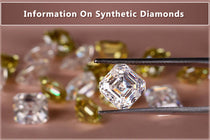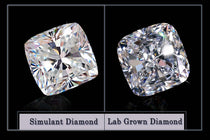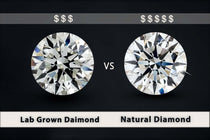If there is a gemstone that gets a universal seal of approval for every jewelry item, it is a diamond. However, with the concerns surrounding mined diamonds, consumers are looking for a more eco-friendly option with the qualities of a natural diamond. Lab grown diamonds provide the same sheen and elegance as mined diamonds with the bonus of being sustainable. When switching to lab grown diamonds, consumers raise a common question: “Are lab grown diamonds more ethical?” If you, too, want an ethically sourced diamond, you can conclude your search with lab grown diamonds and browse Diamondrensu’s exquisite collection to find the perfect stone.
Lab-produced diamonds, also known as synthetic diamonds, are solidifying their presence globally as a considerate and sustainable choice. Unlike mined diamonds, whose production results from a grueling and dangerous practice, lab grown diamonds, as the name suggests, are produced in laboratories. Lab-created diamonds are the spitting image of Earth-mined diamonds, except for one difference. The only difference between lab grown and natural diamonds lies in their origin. Earth mined diamonds are acquired directly from the Earth, involving a long mining process, whereas lab grown diamonds come to life using advanced technology and laboratory practices. Yet, barring their source, both diamonds are identical in every form, from their qualities to their appearance.
 1.0 CT Princess Cut Lab Grown Diamond Engagement Ring
1.0 CT Princess Cut Lab Grown Diamond Engagement Ring
Are Lab Grown Diamonds More Eco-Friendly?
A primary concern regarding Earth-mined diamonds is their negative environmental impact and ethical ramifications. The diamond-mining practice was initially brought up and answered in the 2006 movie Blood Diamond. The eco-friendly nature of lab grown diamonds and the environmental downside of natural diamonds have led to a rapid increase in the demand for the former.
The standard procedure of obtaining mined diamonds includes finding diamond lands, mining for natural diamonds, acquiring, cutting, refining, and selling. Regardless of different techniques to minimize the harmful effects of mining, as long as companies dig up land to search for diamonds, wildlife, and the ecosystem will be affected.
Why are Diamonds Unethical?
Contaminated Water Resources
Mining severely impacts the quality of water resources, as mining and equipment release toxins and acid, making water harmful for consumption. Additionally, soil erosion and waste from mining seep into the water, contaminating it.
Air Pollution
Mining for natural diamonds releases waste particles into the air, polluting the atmosphere. When breathed by animals or miners, the polluted air can lead to health problems. In addition to causing health issues, fuel emissions from mining machinery contribute to global warming, an urgent global concern.
Uprooting Wildlife
Diamond mining has an irreparable impact on wildlife. It causes deforestation and soil erosion, destroys vegetation plantations, and displacement of animals.
Illegal Workforce
In addition to harmful societal and environmental impacts, diamond-mining companies illegally employ workers, often child labor, and force them to work under dangerous and unsanitary conditions.
Are Lab Grown Diamonds More Ethical?
On the other hand, lab grown diamonds are ethically sourced. A diamond lab produces lab grown diamonds using two ways: Chemical Vapor Deposition (CVD) and High-Pressure High-Temperature (HPHT).
Chemical Vapor Deposition
The CVD process locks a tiny diamond seed in a high-temperate chamber and exposes it to carbon gases at low pressures. High temperatures, carbon gases, and low pressures create plasma around the diamond seed. Once the gas particles break down, the carbon atoms stick to the seeds, forming layers.
High-Pressure High-Temperature
Diamond seeds with low inclusions are sealed in a tight sphere press during HPHT. The primary purpose of this method is to create an environment identical to the conditions under which a natural diamond grows. The diamond seeds are exposed to high pressure and temperature until they break into tiny gems. The seeds are left to cool down to transform into pure carbon diamonds.
 1.03 CT Pear Cut Blue Lab Grown Diamond Halo Engagement Ring
1.03 CT Pear Cut Blue Lab Grown Diamond Halo Engagement Ring
Pros and Cons of Lab Grown Diamonds
Even lab grown diamonds have advantages and disadvantages, which are taking the world by storm. If you plan to purchase lab cut diamonds, learning about their plus and minus points will help you make an informed decision. Luckily, their pros outweigh their cons!
Pros of Lab Grown Diamonds
They are Identical to Natural Diamonds
Natural diamonds have a pure chemical composition and structure, making them exceptionally hard and durable. Lab grown diamonds are produced under the same temperature, pressure, and conditions as mined diamonds, giving them the same chemical properties and carbon atom structure. As a result, fire, hardness, sparkle, clarity, and longevity — lab-created diamonds are identical to natural diamonds from every corner.
Are Lab Grown Diamonds Cheaper?
A diamond’s price depends on its 4Cs: clarity, cut, color, and carat. However, regardless of the quality you opt for, natural diamonds are usually expensive to cover the entire mining process, from exploring lands to retail. On the other hand, the cost of lab grown diamonds is 30-40% less than Earth-mined diamonds. This is because lab grown diamonds deliver the qualities of natural diamonds but at a more affordable rate.
Shop Without Feeling Guilty
The origin of natural diamonds is a debated topic, with the majority agreeing that diamond mining is environmentally harmful and unethical. Mined diamonds are blood diamonds obtained from conflict regions, such as Sierra Leone, Angola, Liberia, and the Democratic Republic of Congo. On the flip side, lab-created diamonds are a guilt-free purchase, as they are ethically sourced inside laboratories without unfair working conditions and exploited labor practices.
Environmentally Conscious
Diamond mining removes the top layer of soil with each mining session, causing deforestation, flora displacement, fauna uprooting, and air and water pollution. However, environmental concerns are not an issue with lab grown diamonds, as they do not harm the ecosystem and recycle laboratory-produced waste.
No Impurities
One of the main advantages of buying lab cut diamonds is that they are purer than Earth-mined diamonds. Unlike their natural counterparts, lab grown diamonds do not contain impurities and have more brightness and clarity. Since a lab-created diamond is exposed to carbon gasses and molten, it is a Flawless (F) or Internally Flawless (IF) diamond with slight inclusions only visible under 10x magnification.
Cons of Lab Grown Diamonds
Synthetic Diamond Prejudice
Despite being identical to mined diamonds, the bias against lab-created diamonds, unfortunately, still exists since natural diamonds are considered a conventional choice. If you buy lab diamonds, you might receive jabs or snide remarks accusing you of sporting fake diamonds.
Less Resale Value
If you decide to sell your lab diamonds in the future, the resale value might be underwhelming. Whether a vintage or antique lab diamond, the resale market price is higher for natural diamonds. Unlike mined diamonds, a lab-created diamond’s value might depreciate.
Lab Created Diamonds are Sustainable
Usually, the sustainability of a product is its ability to be used safely and responsibly. The difference between lab grown and natural diamonds lies in their sustainability.
Protection of Natural Resources
The availability of natural substances, such as minerals, natural gas, oil, coal, and stones, is scarce on Earth. Mining increases the rate of non-renewable resource depletion. Since diamond mining requires excavating and digging up land to search for diamonds, the activity affects the availability of natural stones.
Even though diamond labs also process natural resources to produce synthetic diamonds, the materials used during CVD and HPHT are more available than those used in diamond mining. In addition to exhausting fewer resources, lab-produced diamonds do not damage the ecosystem, wildlife, and society and discard production waste safely using recycling methods.
A Popular Choice
Lab-created diamonds have gained an immense following as resource-conscious, ethically sourced, and pocket-friendly gemstones. Their exceptional quality, durability, and reliability have made them an instant hit among millennials who believe in sustainable purchases. The popularity of lab grown diamonds has skyrocketed, with celebrities and non-fashion and non-jewelry brands also actively promoting and sporting synthetic diamonds. Movies, TV shows, red carpet appearances, advertisements, and social media — lab diamonds are stealing the show everywhere.
Diverse Options
Another sustainable quality of lab-produced diamonds is their diversity. Unlike natural diamonds, which are available in fixed colors and designs, lab grown diamonds present a variety of options on a diamond-studded platter. You can adorn a customized ring or wedding band with a lab-created diamond. Suppose you prefer your jewelry with a dash of color, then instead of wearing a colorless natural diamond ring, a 0.81 CT Round Pink Lab Grown Diamond Engagement Ring is right up your alley!
Furthermore, lab grown diamonds are designed to appeal to all generations. Modern, vintage, antique — lab-created diamonds speak to every soul. A flawless blend of old and modern, a lab grown diamond’s sustainability lies in its contemporary nature. Buy lab diamonds and flaunt them wherever you go. Lab diamonds complement every occasion and attire, whether a casual gathering, formal event, office function, business meeting, or engagement party.
Symbolize Social and Environmental Awareness
Most consumers associate lab grown diamonds with elegance, sophistication, and awareness. With the increasing concerns about the depleting condition of Earth, synthetic diamonds have become a beacon of hope, sustainability, and a judicial investment. Lab diamonds allow consumers to adorn stunning jewelry in a safe and considerate manner.
 Round Hearts and Arrows Cut Lab Grown Diamond Ring
Round Hearts and Arrows Cut Lab Grown Diamond Ring







